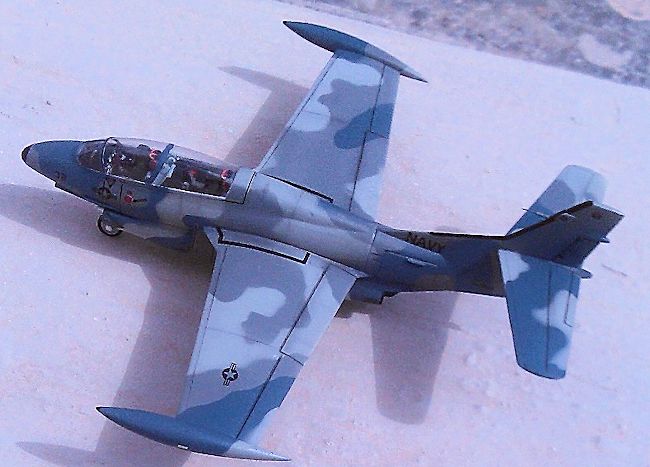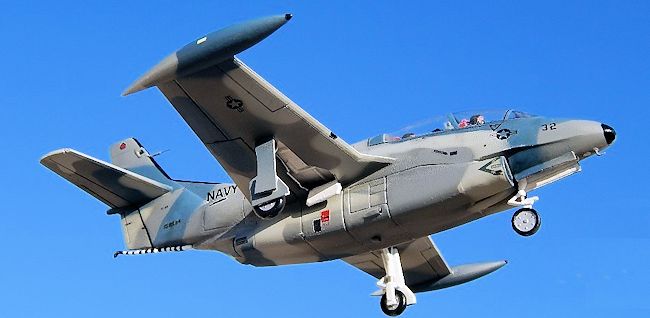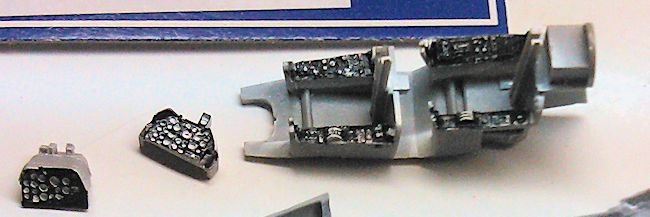
Matchbox 1/72 T-2C Buckeye
| KIT #: | PK-42 |
| PRICE: | $ |
| DECALS: | Two options |
| REVIEWER: | Carmel J. Attard |
| NOTES: | Pavla cockpit set |

| HISTORY |
In 1956 the US Navy identified a requirement for a jet trainer that would be
suitable to take the pupil, after completion of the induction phase through all
the more advanced stages including bombing, gunnery, and fighter tactics, to the
point of carrier qualifications.
 North American Aviation already had proven designs proposals in past from the
FJ-1 Fury to T-28 Trojan. The first of pre-production aircraft, flown initially
on 31st January 1958 was a mid wing configuration accommodating pupil
and instructor in tandem on LS-1 ejection seat, the instructor seat at the rear
was raised to provide good view forward. The design provided a robust landing
gear, powered controls, large trailing edge flaps and an airbrake on each side
of the fuselage and a retractable single type arrestor hook, all hydraulically
actuated.
North American Aviation already had proven designs proposals in past from the
FJ-1 Fury to T-28 Trojan. The first of pre-production aircraft, flown initially
on 31st January 1958 was a mid wing configuration accommodating pupil
and instructor in tandem on LS-1 ejection seat, the instructor seat at the rear
was raised to provide good view forward. The design provided a robust landing
gear, powered controls, large trailing edge flaps and an airbrake on each side
of the fuselage and a retractable single type arrestor hook, all hydraulically
actuated.
The initial production T2J-1 (designated T-2A from 1962) was powered by a single
3,400 lb Westinghouse J-34-WE-48 turbojet within the fuselage. Before entering
into service navalised Buckeye initially equipped BTG-7, later VT-7 at Naval Air
Service Meridian. Production totalled 201 aircraft.
Another version, a T2J-1 conversion was flown on 30th August1962 with
two 3,000 lb thrust Pratt and Whitney J60-P-6 turbojets. This version T-2B
aircraft first flew on 21st May 1965 entering service with VT-4 at
NAS Pensacola. There were 97 production T2Bs. Following evaluation of a T-2B
converted with two General Electric J85-GE-4 engines 231 aircraft designated T2C
were built for US Navy air training.
At a later date a small number of T2B and T2C aircraft were converted as drone
directors under the respective designations DT-2B and DT-2C. The US Navy also
produced two T-2 trainer variants (basically
 similar to the T-2C) on behalf of
Venezuela and Greek Air Forces. The FAV received 12 T-2D trainers in 1973 plus
an additional 12 weapon-capable aircraft in 1976.
similar to the T-2C) on behalf of
Venezuela and Greek Air Forces. The FAV received 12 T-2D trainers in 1973 plus
an additional 12 weapon-capable aircraft in 1976.
One of the current US Navy squadrons that is providing realistic air combat
training to US Navy fighter pilots after the need for such training was
drastically shown in Vietnam based at NAS Oceana, Virginia beach near Norfolk,
Fleet Fighter Squadron VF-43 which also flew F-16N, F5E and A-4s. This involved
the application of a specialized training syllabus and dedicated squadrons of
highly trained and motivated pilots.
These specialized aviators skills could hopefully be transferred to newer
aviators about to go into combat. Among aircraft operated by VF-43 for spin
training is the Rockwell T2 Buckeye. In similar way as the A4s and F-5s also
wore the aggressor style grey camouflage. They were used for giving F-14 pilots
spinning and out of control flight (OCCF) indoctrination impossible in their own
aircraft. The spin training syllabus more formally called “ out of control
Flight Program. This begun in 1979 using T2C Buckeye trainers. Easy and
forgiving to fly the T2 offered an ideal platform for introducing F-14 crew in
the pitfalls of spins as well as showing them how to get out of them.
| THE KIT |
The T2 Buckeye is molded in two colours plastic, white and grey. Taking
advantage of the Matchbox Buckeye kit I have built it to represent a VT-43
trainer aircraft. The kit PK-42 consists of 32 injection molded parts in plastic
with two decal options for a T2C Buckeye of VT-23 1983 or a T2E of 362 Mira
120aPtirx Air Training Command of Hellenic AF 1980.
| CONSTRUCTION |
 first removing by cutting and grinding off all the inside cockpit webbing so
that a completely blank space is produced to take the resin cockpit interior
parts. The kit front and mid instrument coaming was also removed as these are
replaced with resin detail parts.
first removing by cutting and grinding off all the inside cockpit webbing so
that a completely blank space is produced to take the resin cockpit interior
parts. The kit front and mid instrument coaming was also removed as these are
replaced with resin detail parts.
Next step is to paint all the resin detail parts according to the Pavla
instructions that also come with the set. The rear side console comes in way to
the wing root, the part that slots inside the fuselage. This is therefore
removed by cutting a portion 2x8mm.
The nose wheel well resin part and cockpit main assembly are now tried for good
fit and once this is achieved these are fixed in place to one side of fuselage.
A small amount of lead weight is added to the little nose space there is which
proved to be siufficient to hold kit on nose wheel. Other resin detail parts are
now fixed in place namely side consoles, rudder pedals, ejection seats, control
columns and front and
 middle cockpit coaming and instrument panels taking care
that tiny detail such as ejection seat handles are not damaged during the
process. From then on the assembly is a straightforward one. A little filler was
required to the wing to fuselage joint. The fuselage could npw be closed and
fixed permanently.
middle cockpit coaming and instrument panels taking care
that tiny detail such as ejection seat handles are not damaged during the
process. From then on the assembly is a straightforward one. A little filler was
required to the wing to fuselage joint. The fuselage could npw be closed and
fixed permanently.
It was the turn to add external detail to fuselage. This consisted of an ‘L’shaped antenna positioned under the nose which was made from a piece of metal wire; two small air intakes which were added under the fuselage, that are shaped from small pieces of scrap plastic.. There are now 5 air intakes fitted to fuselage, three of these existed. The front of these was hand drilled with a .4mm diameter drill. Two anti spin streaks , made from thin strips of plastic were added , one to just above the engine air intakes and the other above the air break all to each side of fuselage. The clear, thin vac form cockpit is now trimmed and fitted in place, replacing the Matchbox kit part. Crew figures were also added prior to closing the cockpit canopy.
The kit was finished as a Buckeye attached to VF-43 which is in 3-tone grey wrap
round camouflage which are FS 35164 intermediate blue (Compucolor), FS 36231
Dark Gull Grey (Modelmaster) and FS 36440 (Modelmaster). Markings came from
spares box mainly of Scale master brand. Kit was given a semi gloss sheen using
Modelmaster lacquer.
| CONCLUSIONS |
October 2014
If you would like your product reviewed fairly and fairly quickly, please contact the editor or see other details in the Note to Contributors.